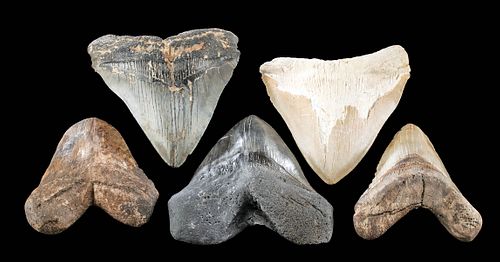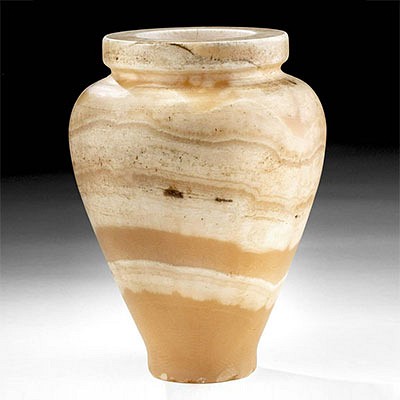Fossilized Megalodon Teeth - Group of 5
Lot 89a
About Seller
Artemis Gallery
686 S Taylor Ave, Ste 106
Louisville, CO 80027
United States
Selling antiquities, ancient and ethnographic art online since 1993, Artemis Gallery specializes in Classical Antiquities (Egyptian, Greek, Roman, Near Eastern), Asian, Pre-Columbian, African / Tribal / Oceanographic art. Our extensive inventory includes pottery, stone, metal, wood, glass and textil...Read more
Categories
Estimate:
$1,800 - $2,500
Absentee vs Live bid
Two ways to bid:
- Leave a max absentee bid and the platform will bid on your behalf up to your maximum bid during the live auction.
- Bid live during the auction and your bids will be submitted real-time to the auctioneer.
Bid Increments
| Price | Bid Increment |
|---|---|
| $0 | $25 |
| $300 | $50 |
| $1,000 | $100 |
| $2,000 | $250 |
| $5,000 | $500 |
| $10,000 | $1,000 |
| $20,000 | $2,500 |
| $50,000 | $5,000 |
| $100,000 | $10,000 |
| $200,000 | $20,000 |
About Auction
By Artemis Gallery
Dec 17, 2020
Set Reminder
2020-12-17 10:00:00
2020-12-17 10:00:00
America/New_York
Bidsquare
Bidsquare : VARIETY SALE | Antiquities & Ethnographic Art
https://www.bidsquare.com/auctions/artemis-gallery/variety-sale-antiquities-ethnographic-art-6207
Featuring classical antiquities, ancient and ethnographic art from cultures encompassing the globe. Egyptian, Greek, Roman, Etruscan, Near Eastern, Asian, Pre-Columbian, Native American, African / Tribal, Oceanic, Spanish Colonial, Russian, Fossils, Fine Art, more! Artemis Gallery info@artemisgallery.com
Featuring classical antiquities, ancient and ethnographic art from cultures encompassing the globe. Egyptian, Greek, Roman, Etruscan, Near Eastern, Asian, Pre-Columbian, Native American, African / Tribal, Oceanic, Spanish Colonial, Russian, Fossils, Fine Art, more! Artemis Gallery info@artemisgallery.com
- Lot Description
Ancient Seas, ca. 2 million years ago. A wonderful ensemble of Megalodon teeth with an array of different colors formed via the process of fossilization. The first tooth has mottled brown and russet hues across both enamel and root. Second is a black tooth with visible serrations and a finely striated bourlette (upper enamel). The third tooth has a beige root, dark-orange hues on the bourlette, and a brown root with smooth surfaces. Fourth is a caramel-hued tooth with a missing root and chipped enamel that reveals the interior structure of the tooth. The largest tooth has a black bourlette, mottled brown and grey hues on the root, and orange-hued deposits within the root. Size of largest (orange root deposits): 4.625" W x 5.25" H (11.7 cm x 13.3 cm).
Megalodon (Carcharodon megalodon, literally "big tooth"), thought to have become extinct 1.6 million years ago, is the largest known member of the shark family. Prior to 1666, when naturalist Nicolaus Steno studied shark teeth and realized the error, people believed that these teeth were moon rocks or dragon's tongues. Megalodon teeth are all that remain of these ancient creatures, whose skeletal structures - like those of all sharks - were made of cartilage and did not fossilize. Interestingly, a megalodon's age at death can be determined by the growth rings radiating from the centra of the tooth.
Provenance: ex private Ventura County, California, USA collection, acquired prior to 2008
All items legal to buy/sell under U.S. Statute covering cultural patrimony Code 2600, CHAPTER 14, and are guaranteed to be as described or your money back.
A Certificate of Authenticity will accompany all winning bids.
We ship worldwide and handle all shipping in-house for your convenience.
#153929Restoration to half of brown-and-russet tooth and smaller black tooth, with resurfacing and overpainting along new material and break lines; three remaining teeth - with brown root, chipped enamel, and orange root deposits - are intact and excellent. Each tooth has chips and abrasions to enamel, bourlette, and root, with light encrustations. Light earthen deposits and great patina throughout.Condition
- Shipping Info
-
All shipping is handled in-house for your convenience. Your invoice from Artemis Gallery will include shipping calculation instructions. If in doubt, please inquire BEFORE bidding for estimated shipping costs for individual items.
-
- Buyer's Premium



 EUR
EUR CAD
CAD AUD
AUD GBP
GBP MXN
MXN HKD
HKD CNY
CNY MYR
MYR SEK
SEK SGD
SGD CHF
CHF THB
THB













